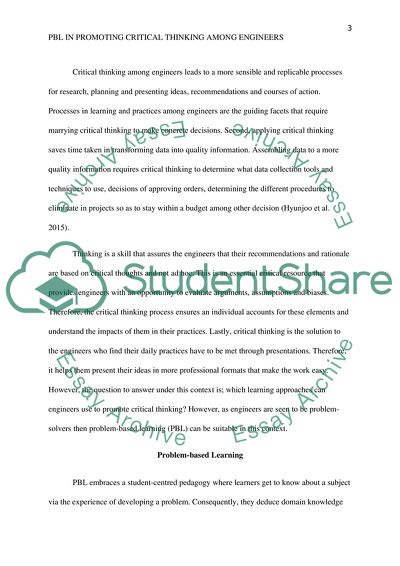Cite this document
(Problem-Based Learning in Promoting Critical Thinking among Engineers Essay Example | Topics and Well Written Essays - 1250 words, n.d.)
Problem-Based Learning in Promoting Critical Thinking among Engineers Essay Example | Topics and Well Written Essays - 1250 words. https://studentshare.org/education/1874328-engineers-often-have-to-apply-critical-thinking-skills-to-both-their-academic-and-professional-practices-problem-based-learning-is-one-of-the-tools-used-to-promote-this-discuss-the-benefits-of-this-and-compare-this-method-with-one-other-teaching-approac
Problem-Based Learning in Promoting Critical Thinking among Engineers Essay Example | Topics and Well Written Essays - 1250 words. https://studentshare.org/education/1874328-engineers-often-have-to-apply-critical-thinking-skills-to-both-their-academic-and-professional-practices-problem-based-learning-is-one-of-the-tools-used-to-promote-this-discuss-the-benefits-of-this-and-compare-this-method-with-one-other-teaching-approac
(Problem-Based Learning in Promoting Critical Thinking Among Engineers Essay Example | Topics and Well Written Essays - 1250 Words)
Problem-Based Learning in Promoting Critical Thinking Among Engineers Essay Example | Topics and Well Written Essays - 1250 Words. https://studentshare.org/education/1874328-engineers-often-have-to-apply-critical-thinking-skills-to-both-their-academic-and-professional-practices-problem-based-learning-is-one-of-the-tools-used-to-promote-this-discuss-the-benefits-of-this-and-compare-this-method-with-one-other-teaching-approac.
Problem-Based Learning in Promoting Critical Thinking Among Engineers Essay Example | Topics and Well Written Essays - 1250 Words. https://studentshare.org/education/1874328-engineers-often-have-to-apply-critical-thinking-skills-to-both-their-academic-and-professional-practices-problem-based-learning-is-one-of-the-tools-used-to-promote-this-discuss-the-benefits-of-this-and-compare-this-method-with-one-other-teaching-approac.
“Problem-Based Learning in Promoting Critical Thinking Among Engineers Essay Example | Topics and Well Written Essays - 1250 Words”. https://studentshare.org/education/1874328-engineers-often-have-to-apply-critical-thinking-skills-to-both-their-academic-and-professional-practices-problem-based-learning-is-one-of-the-tools-used-to-promote-this-discuss-the-benefits-of-this-and-compare-this-method-with-one-other-teaching-approac.


